Intricate Design: The Engineering Marvel of the Human Tongue
The human tongue is one of nature’s most sophisticated biological instruments—a muscular marvel that seamlessly integrates multiple complex functions essential to human survival and communication. From its intricate anatomy to its diverse capabilities, the tongue demonstrates extraordinary biological engineering that continues to fascinate researchers across multiple scientific disciplines.
ANATOMICAL COMPLEXITY THAT DEFIES IMAGINATION
The tongue consists of eight distinct muscles working in perfect coordination: four intrinsic muscles that alter its shape, and four extrinsic muscles that control its position. This muscular architecture enables an astounding range of movements—the tongue can extend, retract, curl, twist, and form precise shapes with remarkable speed and accuracy. Unlike any other organ, it operates without skeletal support, relying entirely on sophisticated muscular control.
The surface architecture alone reveals extraordinary complexity. Approximately 10,000 taste buds, each containing 50-100 specialised receptor cells, cover the tongue’s surface in strategic patterns. These microscopic sensors can detect five primary tastes—sweet, sour, salty, bitter, and umami—while discriminating between thousands of distinct flavour combinations. Recent research reveals taste perception involves intricate molecular interactions, with individual receptor proteins recognising specific chemical signatures with extraordinary precision.
THE SPEECH PRODUCTION SYSTEM
Perhaps nowhere is the tongue’s engineering more evident than in human speech production. The tongue works in concert with the larynx, teeth, lips, and soft palate to create the incredible diversity of human language sounds. Remarkably, the tongue can assume dozens of distinct positions within milliseconds, enabling the rapid articulation necessary for fluent speech.
Phonetic research demonstrates that tongue positioning accuracy must be precise to within millimetres to produce distinguishable sounds. The tongue tip alone can execute movements requiring coordination between multiple muscle groups, while simultaneously maintaining the proper tension and shape for specific phonemes. This level of motor control rivals the most sophisticated robotic systems ever developed.
MULTIFUNCTIONAL INTEGRATION
What makes the tongue truly remarkable is its ability to seamlessly integrate multiple functions simultaneously. While eating, it must coordinate taste detection, food manipulation, chewing assistance, and swallowing—all while potentially continuing speech production between bites. This multitasking capability requires extraordinary neural coordination.
The tongue’s sensory systems extend far beyond taste. Specialised mechanoreceptors detect texture, temperature, and pressure with incredible sensitivity. These tactile sensors can distinguish between materials with surface variations measured in micrometres, providing crucial feedback for food safety and processing.
NEURAL NETWORK SOPHISTICATION
The tongue’s operation requires extensive neural networking. The hypoglossal nerve controls motor functions through approximately 100,000 nerve fibres—more than many other organs require for their primary functions. Meanwhile, three different cranial nerves handle sensory input: the facial, glossopharyngeal, and vagus nerves each contribute specialised sensory information.
This neural complexity enables the tongue’s remarkable adaptability. Following injury or changes in oral structure, the tongue demonstrates extraordinary plasticity, often developing compensatory movement patterns that maintain both speech clarity and swallowing efficiency.
DEVELOPMENTAL PRECISION
The tongue’s development showcases remarkable biological precision. During embryonic development, multiple cell populations migrate and differentiate with extraordinary timing and spatial accuracy. Taste bud formation follows precise genetic programming, while muscle fibre organisation creates the exact anatomical arrangements necessary for future function.
Recent developmental biology research reveals that tongue formation involves complex molecular signaling pathways that must activate in specific sequences. Any disruption in this precisely timed process can result in significant functional impairments, highlighting the critical importance of each developmental step.
MAINTENANCE AND REGENERATION
The tongue demonstrates remarkable self-maintenance capabilities. Taste buds completely regenerate every 7-14 days throughout an individual’s lifetime—a feat requiring continuous stem cell activity and precise cellular replacement mechanisms. The tongue’s surface can heal rapidly from injury while maintaining sensory function, and its muscular structure adapts to changing demands throughout life.
INTELLIGENT DESIGN PERSPECTIVES
Intelligent Design (ID) proponents argue the tongue’s sophisticated architecture points to purposeful engineering rather than undirected evolutionary processes. From their perspective, several features of the tongue suggest intentional design rather than gradual modification.
ID theorists emphasise the concept of irreducible complexity, arguing the tongue’s multiple integrated systems could not function effectively without all components being present simultaneously. They point to the precise coordination required between the eight muscles, the specific positioning of taste buds, and the exact neural pathways necessary for both taste and speech as evidence of systems that must work together as complete units.
The information-processing capabilities of taste reception particularly interest ID proponents. They argue the molecular recognition systems in taste buds—where specific receptor proteins identify particular chemical structures with extraordinary precision—demonstrate sophisticated information processing that parallels designed recognition systems. The ability of these receptors to distinguish between thousands of molecular variations while maintaining consistent responses suggests, from their viewpoint, programming-like specificity.
Multifunctional integration: ID advocates also highlight the tongue’s multifunctional integration as evidence of purposeful design. They argue the seamless coordination of taste, speech, swallowing, and food manipulation represents the kind of multi-purpose engineering typically seen in sophisticated designed systems. The tongue’s ability to perform multiple complex tasks simultaneously without interference between functions suggests, in their view, intentional optimization rather than evolutionary accident.
The developmental precision of tongue formation provides another focal point for ID arguments. They note the embryonic development process requires numerous molecular signals to activate in precise sequences, with exact timing and spatial coordination. Any significant disruption results in functional impairment, suggesting to ID proponents that the developmental program reflects purposeful biological engineering.
Regenerative and adaptive capabilities: Additionally, ID theorists point to the tongue’s remarkable regenerative capabilities and adaptive responses as evidence of built-in maintenance and optimisation systems that exceed what they consider likely products of undirected evolutionary processes.
CONCLUSION: ENGINEERING IMPLICATIONS
Modern engineering continues to study the tongue’s design principles for technological applications. Roboticists examine its movement capabilities for developing more sophisticated manipulation systems, while food scientists study its sensory mechanisms for creating better artificial taste detection systems.
The tongue’s combination of strength, sensitivity, speed, and multi-functionality represents a biological achievement that current technology cannot replicate. Its seamless integration of mechanical, sensory, and neural systems creates a unified instrument of extraordinary capability.
This remarkable organ reminds us that even seemingly simple biological structures often contain extraordinary depths of complexity and capability, deserving our continued study and appreciation.
ENGINEERING MARVEL OF THE HUMAN TONGUE: RELATED FAQs
How does the tongue’s strength compare to other muscles in the human body? From a creationist and ID perspective, the tongue’s exceptional strength-to-size ratio demonstrates purposeful engineering for its demanding functions. Despite its relatively small size, the tongue can exert forces comparable to much larger muscle groups. This suggests intentional optimisation for its multiple roles. This strength appears precisely calibrated for tasks ranging from delicate taste discrimination to powerful food manipulation, indicating designed functionality rather than evolutionary accident.
- Why do we have such precise taste discrimination compared to other animals? Creationists and ID proponents argue human taste sophistication reflects unique design purposes, particularly for cultural and social functions around food preparation and enjoyment. The ability to detect subtle flavour differences and appreciate complex taste combinations appears to exceed basic survival needs. This suggests design for higher purposes including aesthetic appreciation and social bonding through shared meals. This level of sensory refinement points to intentional enhancement beyond mere evolutionary utility.
- How does tongue development in the womb demonstrate design principles? The embryonic tongue development process requires over 40 distinct genes to activate in precise sequences with exact timing coordination. ID theorists view this as clear evidence of programmed development, where multiple molecular pathways must coordinate perfectly to produce functional outcomes. Any significant deviation results in serious developmental disorders. This suggests the process operates more like engineered manufacturing protocols than random evolutionary assembly.
What makes human speech articulation uniquely complex among animals? Creationist perspectives emphasise human speech capabilities appear qualitatively different from animal communication, requiring unprecedented coordination between tongue, larynx, and brain systems. The precision needed for phoneme production—accurate to within millimetres and milliseconds—suggests engineering specifically for complex language rather than gradual evolution from simpler vocalizations. This supports views that we’re uniquely designed for sophisticated communication and abstract thought.
- How does the tongue’s self-repair system indicate intelligent design? The tongue’s remarkable healing capabilities and continuous taste bud regeneration throughout life suggest built-in maintenance programming typical of well-designed systems. ID proponents note the tongue maintains full functionality even while constantly replacing its sensory components—a feat requiring sophisticated cellular coordination and quality control mechanisms. This level of self-maintenance appears to exceed what undirected evolutionary processes would typically produce.
- Why is the tongue’s neural wiring so much more complex than necessary for basic functions? From an ID standpoint, the tongue’s extensive neural networking—involving more nerve fibres than many organs require for their primary functions—suggests design for capabilities beyond basic survival needs. The sophisticated sensory integration and motor control systems appear over-engineered from a purely utilitarian evolutionary perspective. This complexity better fits design models that anticipate advanced functions including speech, aesthetic appreciation, and complex social interactions.
How do the tongue’s multiple simultaneous functions challenge gradual evolutionary explanations? Creationists argue the tongue’s ability to coordinate taste, speech, swallowing, and food manipulation simultaneously requires systems integration that defies step-by-step evolutionary assembly. Each function requires specific anatomical features, neural pathways, and muscular coordination that must work together without interfering with other functions. This integrated complexity suggests all systems were designed to work together from the beginning, rather than assembled gradually through separate evolutionary modifications.
ENGINEERING MARVEL OF THE HUMAN TONGUE: OUR RELATED POSTS
- The Human Knee: Where Evolution’s Kneejerk Explanations Fail
- The Inverted Retina: Design Flaw Or Optimal Engineering?
- The Ankle and Feet: A Miracle of Precision Engineering
- Our Consciousness and Rationality: Is God the Best Explanation?
- DNA Evidence for Intelligent Design: New Challenges for Evolution
- Human Immunology: Evidence of Design in Our Defence Systems
- Nature’s Ultimate Computer: The Human Brain Defies Evolution
- Haemoglobin Screams Design: A Miracle in Every Breath
Editor’s Pick

Blue Whales: Mammoth Icons of Intelligent Design
Imagine an animal so massive its heart alone weighs as much as a small car, yet so precisely engineered it [...]

Do Unbelieving Kids Disqualify Church Leaders?
REFORMED PERSPECTIVES ON 1 TIMOTHY 3 AND ELDER QUALIFICATIONS Every pastor knows the heartbreak. A faithful elder who has served [...]

Why Did God Kill Onan? Wasn’t the Punishment Disproportionate?
The story of Onan in Genesis 38 troubles many. Why would God strike down a man for what seems like [...]

Is God Preparing Me for Ministry? How May I Know for Sure?
The question haunts many faithful believers. You’re serving faithfully in your local church, perhaps teaching Sunday school or leading a [...]

Ephesians 1:13: Was the Spirit’s Indwelling Promised of Old?
When Paul declares believers are “sealed with the promised Holy Spirit” in Ephesians 1:13, one word jumps off the page: [...]

Monergism vs Synergism: Is Salvation God’s Work Alone?
When God saves us, does He do it alone, or does He need our help? The question isn’t mere theological [...]

Was Jesus Abandoned by the Father on the Cross?
WHY WE ANSWER IN THE NEGATIVE “My God, my God, why have you forsaken me?” These words from the cross [...]

Why Do Some Respond to God’s Call While Others Don’t?
THE REFORMED VIEW ON OUTWARD AND INWARD CALLS EXPLAINED Picture this: Two neighbours attend the same church service. They hear [...]

Does Ocean Salt Content Prove a Young Earth?
A COMPELLING LOOK AT MARINE CHEMISTRY AND EARTH’S TIMELINE The Salt Question That Challenges Deep Time: If Earth’s oceans have [...]
Noah’s Flood: Where Did All the Water Come From? And Go?
The question hits every Bible-believing Christian at some point: “If Noah’s flood covered the whole earth, where did all that [...]






